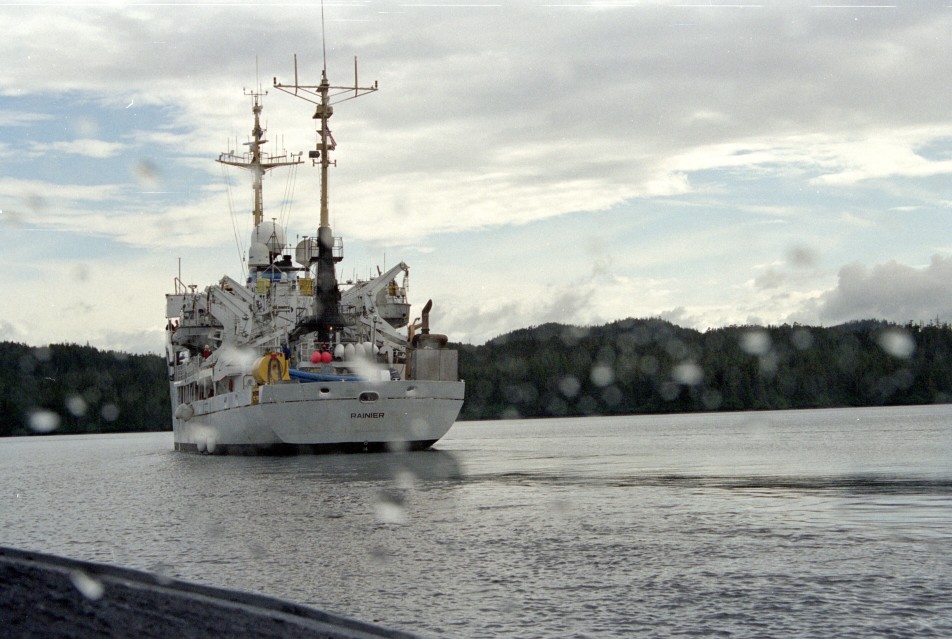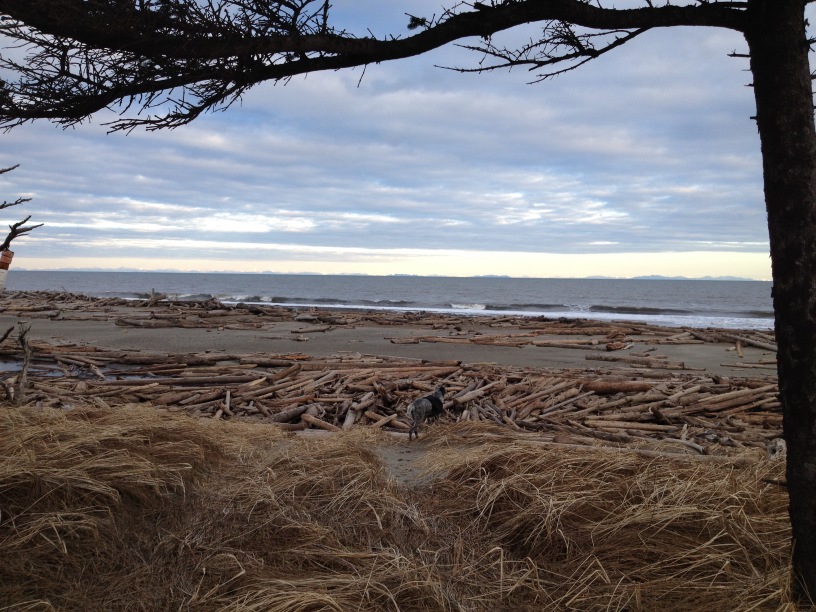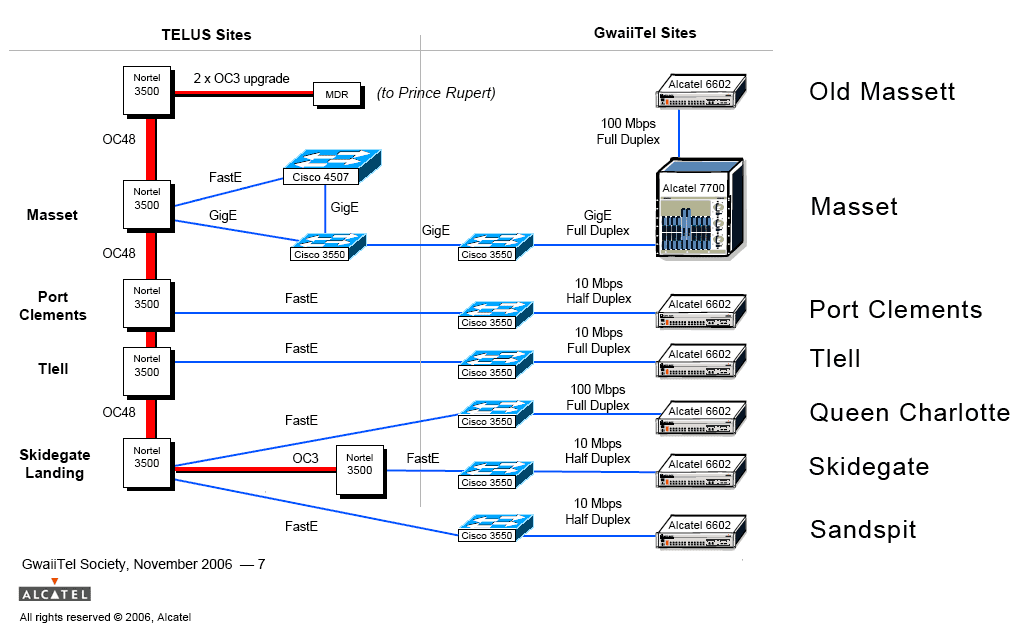Haida Gwaii's so called "Massive Internet Upgrades" Local fibre does not equal better Internet
Working Remotely
For the last sixteen months, when I “go to work” everyday, I walk from one room in my house to the other room in my house, sit down in front of a pair of giant computer monitors, a web cam, and start talking to people 1000 kilometers (that’d be 1 megameter) away. I’m extremely lucky to be one of the people who can work anywhere, as long as I have a reliable Internet connection.
When Rosie and I were talking about whether we could move up to Masset, on Haida Gwaii, I was a little concerned about the remoteness and whether I could stay in good contact. Afterall, I had worked on survey boats a few hundred kilometers north of here off of a VSAT Internet connection and it was pretty awful. Low bandwidth. Long delays. It was pretty much impossible to do anything interactively. I could make it work, but it was substantially less productive. Not to mention that I was only responsible for myself and didn’t have to manage anyone, like I do now.
 Does it look like you can get a good connection bobbing in the ocean like this?
Does it look like you can get a good connection bobbing in the ocean like this?
I did extensive research on Haida Gwaii’s Internet connection, pouring over their network diagrams, reading GwaiiTel’s press releases over the last 10 years, e-mailing folks from the local network providers and taking network latency measurements. I was pretty confident coming up here, that the network was going to be sufficiently performant to be able to work, develop software, video conference, etc. The research paid off and I wasn’t disappointed.
How is the Haida Gwaii Internet connection?
But, Haida Gwaii’s network is certainly not perfect. Our 4000 residents are connected to the Internet by an overwater microwave link (Microwave Digital Radio or MDR). It provides about 300 Mbps of bandwidth for the whole island, which is not great. Bandwidth is limited enough to be metered and we have to pay a hefty sum to buy it (around $2 / GB). It’s susceptible to weather interruptions, particularly in the winter when the gales blow our tower off alignment or the rain, wind and clouds provide enough atmospheric interference to limit our data throughput. During last night’s storm, I was down to around 20 KBps.
 I know there’s an Internet over there somewhere…
I know there’s an Internet over there somewhere…
Suffice it to say, the MDR link is our bottleneck. However, because my work depends so heavily on a solid Internet connection, I was heartend to read that GwaiiTel was planning on “Massive Internet Upgrades” and had secured $10 million in funding to do so. Heartened, that is, until I actually read their plan and realized that:
- Their plan focuses almost entirely on the local island inTRAnet, and
- Their plan will not help the northern communities of Masset, Old Masset, or Tow Hill in any way.
Allow me to explain.
GwaiiTel’s present network architecture is laid out like this:
 GwaiiTel’s Network Architecture
GwaiiTel’s Network Architecture
At present the local island intranet is carried over fibre owned by Telus, and Ethernet links of between 10 and 100 Mbps extend into each of the various communities. Except for the Tow Hill Community. They are hung out to dry with no network connectivity whatsoever. Masset is exceptional in that it has Gigabit Ethernet connecting us to the MDR link, so we can actually pull (3 times) more traffic across our local network than the remote connection supports. The other communities (e.g. Sandspit) saturate their 10 Mpbs connections long before their traffic gets to the tower to be sent to Rupert.
A simplified and inexact (but to scale) network architecture looks something like this:
GwaiiTel plans to do two things.
- Build a second MDR tower
- Build fibre up the length of the island
A second tower
First of all they want to build a second tower in Old Masset “for redundancy” and to double the available bandwidth across the MDR link. In principle, this sounds like a great idea. Bandwidth to Rupert is our biggest limitation, so I’m all for increasing the amount of bandwidth that’s available. However, there are a couple of problems with this. The first is that they don’t actually need to build another tower to increase the bandwidth. When the first tower was built, almost 10 years ago, it was designed with the ability to expand the amount of spectrum that it used and the bandwidth that it could carry. GwaiiTel’s website said that it could “provide another 750 Mbps that could theoretically… bring total Internet access capacity over that radio link up to 850 Mbps.” So, why do we need a second tower then? Why not just fill up the capacity on the first tower?
Network diagram with double the bandwidth to Rupert
I’ll leave that one alone for a minute, because there’s another bigger problem with this plan. Even though doubling the bandwidth is certainly a good thing, it’s a drop in the bucket compared to the scale of how much they’re increasing on-island bandwidth.
Fibre up the island
The second, and most ambitious part of GwaiiTel’s plan is to build a 110km fibre line from Masset to Queen Charlotte, connecting the communities along the way. Fibre provides a ridiculous amount of bandwidth. Depending on the setup, that could be up to 1 terabits/second (Tbps) which around 10,000-100,000 times greater than the existing networks for the southern communities. That would be awesome if there were anywhere for that traffic to go. We’re only increasing our off-island link by 2 times, but increasing the on-island traffic by 100,000 times. That sounds like a recipe for disaster. It’s analogous to building a super highway down the length of the island, and then claiming that it’s going to help us get goods and freight across the ferry more quickly. The ferry line is still the bottleneck.
Over-the-top intranet and underpowered Internet
This diagram isn’t to scale, because I couldn’t make the on island links big enough to keep them from filling up the page. Oh, and Tow Hill continues to be left out to dry without connectivity since the fibre will be constructed from Masset to Charlotte. So essentially GwaiiTel is spending upwards of $10 milllion to give all of the communities south of Masset greater access to an already limited resource. Why not balance this plan out by spending a greater portion of the resources on expanding the bandwidth to Rupert? Scale back the fibre, and scale up the MDR to bring the Internet connection and the intranet connection into closer alignment with each other. And if you’re going spend all the money on fibre, then at least take it out to the end of the power lines on Tow Hill Road and bring in those extra few hundred potential subscribers that have no access at present.
Advantages?
Maybe I’m being a little too harsh and critical. Afterall, I am actually happy that our network carrier is a non-profit that’s owned and run by the island communities. I’m happy to see them bring some infrastructure funding to the island, so what positive things can I say about the proposal?
Greater intra-network bandwidth has the potential to allow the development of on-island network services. For example organizations (e.g. Gwaii Trust, Haida Nation) that have offices at both ends of the island can feasibly develop intra-net services like file sharing and video conferencing and not have to send their traffic off-island. This could be a big deal, but those services don’t actually exist right now. This only provides the baseline infrastructure to develop them. And currently GwaiiTel doesn’t actually report on-island vs. off-island traffic to the ISPs, so there’s not yet any billing infrastructure to support this.
This network setup is more fair to all of the communities (except Tow Hill and Sandspit). Masset will no longer enjoy an unfair advantage of having first shot at the MDR link while everyone else is on the other side of a 10/100 Mb bottleneck. Sucks for us, but we can’t claim that it’s not fair.
Having a second tower might provide more redundancy. I’m not an expert on MDR, but it seems to me that because of the long distance of the link, having a second tower in the same community and pointing the link at the same tower on the mainland, it doesn’t really provide any true redundancy. The signals are going to have to traverse the same weather systems and will be subject to the same challenges. It will be owned by GwaiiTel instead of having to lease space from Telus, so maybe that’s an advantage. The same goes for the fibre line. Maybe it will be less expensive to have our own fibre than to lease it from Telus.
All in all though, the benefits are kind of thin from the users’ perspectives, particularly North Island users.
South Island Bottlenecks
Take one last look at the network architecture above. Notice that Haida Gwaii’s intranet traffic is already carried by fibre owned by Telus (sooooo… why do we need to build another fibre line?). The actual network bottlenecks for southern communties are the short 10 Mbps and 100 Mbps ethernet links that connect the communities to the Telus back haul. These are short links and it would be relatively economical to upgrade them to 1 Gbps ethernet, bringing them in line with the community link between the MDR and Masset. Then the savings could be spent on adding more spectrum to the existing tower and building a second tower. Then we could actually get our entire network connection up to somewhere around 1.7 Gbps which would be accessible to the whole island. Compare that to the 700 Mpbs that we’ll get under the current plan.
Conclusions
This project, as it has been designed, is a missed opportunity. Rather than working to resolve the existing off-island bottleneck, GwaiiTel has chosen to build expensive on-island infrastructure that will not actually address the limitations of our Internet connection. They are increasing the on-island capacity by 10,000 to 100,000 times while only increasing our off-island capacity by 2 times. The analogy is that GwaiiTel has chosen to build a super-mega-highway up and down the island, while continuing to rely on slow and infrequent ferry service to carry our traffic to the mainland. Rather than spreading the benefits across all of GwaiiTel’s constituency, the benefits will be realized only by communities south of Masset. This project is pretty much a done deal and I wish GwaiiTel the best. But I hope that in the future, GwaiiTel will actally do some community consultation and attempt to actually address the problems that we’re having now.
Update (2015-11-16): GwaiiTel board member, Berry Wijdeven has stated that GwaiiTel will be doubling the island’s bandwidth by adding two more antanae to the existing tower in Masset and not by building a second tower in Old Masset. This is not clear, especially given that the Haida Gwaii Observer finished their 2015-11-13 article stating that, “The second set of radio transmitters that will send a stronger single [sic] to Old Massett should be installed by the end of 2015.” Regardless of how the bandwidth is doubled, I still contend that doubling the bandwidth is disproportionately small compared to the investments in the intra-island network traffic.
blog comments powered by Disqus